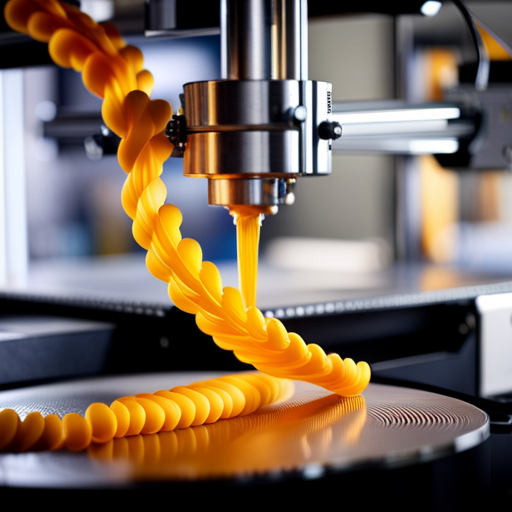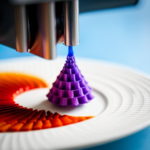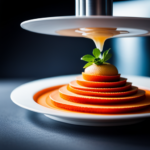Step into the future of culinary innovation as we explore the tantalizing world of personalized food design with 3D printing.
Imagine a world where every dish is meticulously crafted to suit individual tastes and dietary needs, all brought to life with the precision of 3D printing technology.
Join us as we delve into the evolution of this groundbreaking culinary art form, the impact it has on the food industry, and the exciting possibilities that lie ahead.
The Evolution of 3D Food Printing
The evolution of 3D food printing has revolutionized the culinary industry. This innovative technology has paved the way for culinary innovation, offering chefs and food designers the ability to create intricate and personalized food designs that were previously impossible to achieve. 3D food printing technology allows for the precise layering of food materials to construct complex and visually stunning edibles. This has not only expanded the possibilities for artistic food presentation but has also opened doors for personalized nutrition, catering to individual dietary needs and preferences.
The culinary world has embraced 3D food printing as a means to push the boundaries of traditional food preparation. Chefs are now able to experiment with textures, shapes, and flavors in ways that were once unimaginable. This technology has the potential to disrupt traditional modes of food production and distribution, offering a sustainable and efficient way to create food products.
As 3D food printing continues to advance, it holds the promise of not only enhancing the dining experience but also addressing food security and sustainability challenges. This evolution signifies a remarkable leap forward in the realm of culinary arts, marking a new era of creativity and possibility.
Customized Culinary Creations
Advancing from the capabilities of 3D food printing, customized culinary creations allow for tailored food experiences, catering to individual preferences and dietary requirements. Culinary technology has enabled a new era of food customization, revolutionizing the way we prepare and consume meals.
Here are some key aspects of customized culinary creations:
-
Personalized Nutrition: Customized culinary creations can be tailored to meet specific dietary needs, such as low-carb, high-protein, or gluten-free options, ensuring that individuals can enjoy meals that align with their nutritional requirements.
-
Flavor Infusion: Culinary technology enables the infusion of unique flavors into dishes, offering a personalized taste experience that caters to individual preferences, whether it’s a specific spice blend or a particular level of seasoning.
-
Aesthetic Presentation: With 3D food printing and other culinary technologies, chefs can create visually stunning and personalized food presentations, enhancing the overall dining experience.
-
Specialized Diets: Customized culinary creations can accommodate specialized diets, such as vegan, vegetarian, or keto, providing a wide range of options for individuals with specific dietary restrictions.
The integration of culinary technology into food customization not only enhances the dining experience but also opens up new possibilities for personalized nutrition and gastronomic innovation.
Advancements in Edible Printing Materials
Advancements in edible printing materials have significantly expanded the possibilities for personalized food design with 3D printing. Edible ink, specifically designed for use in 3D food printers, allows for intricate and colorful designs to be printed onto food items, enhancing their visual appeal. Moreover, flavor infusion technology enables the incorporation of various flavors into the printed food, providing a unique and customized taste experience.
In addition to enhancing the aesthetic and sensory aspects of personalized food design, advancements in edible printing materials also contribute to sustainable packaging and nutritional customization. Sustainable packaging materials compatible with 3D food printing are being developed, reducing the environmental impact of food packaging. Furthermore, the ability to customize the nutritional content of printed food items enables the creation of personalized dietary options tailored to individual needs and preferences. This not only caters to specific dietary requirements but also opens up new possibilities for personalized nutrition and wellness.
Impact on Food Industry and Dining Experience
With the integration of 3D printing technology, personalized food design has significantly impacted the food industry and transformed the dining experience. This transformation has brought about several notable changes:
-
Improved Food Safety: 3D printing allows for precise control over ingredients and production processes, reducing the risk of contamination and ensuring higher food safety standards.
-
Enhanced Sustainability: By utilizing 3D printing to create food, the industry can explore alternative ingredients and sustainable food sources, contributing to a more sustainable food supply chain.
-
Reduced Waste: The ability to create customized portions and shapes through 3D printing minimizes food waste by producing only what is needed, thus reducing the environmental impact of excess food disposal.
-
Elevated Dining Experience: Personalized food design adds a new dimension to the dining experience, allowing for unique, visually appealing dishes that cater to individual tastes and dietary requirements.
The adoption of 3D printing in the food industry not only addresses concerns related to food safety and sustainability but also enhances the overall dining experience while contributing to waste reduction efforts.
Future Possibilities and Innovations
Exploring future possibilities and innovations in personalized food design through 3D printing, the food industry is poised to revolutionize culinary creativity and nutritional customization.
One of the future applications of 3D printing in food design is the potential to cater to individuals with specific dietary needs, such as creating personalized meals for people with allergies, intolerances, or chronic conditions.
This technology opens creative possibilities for chefs and food designers to experiment with intricate and visually stunning edible creations that were previously unattainable using traditional methods.
Moreover, 3D printing allows for the precise control of nutritional content, enabling the customization of food based on an individual’s nutritional requirements. This could lead to the development of personalized dietary plans and tailored nutrition for athletes, patients, or individuals with specific health goals.
Additionally, as the technology advances, there is potential for 3D-printed food to be utilized in space exploration and as a sustainable solution for addressing food scarcity.
The future holds limitless creative and practical applications for 3D-printed food, promising a paradigm shift in the way we perceive, prepare, and consume meals.
Frequently Asked Questions
What Are the Potential Health and Safety Concerns Associated With Consuming 3D Printed Food?
Health risks and safety concerns associated with consuming 3D printed food include potential contamination, use of non-food-grade materials, and lack of standardized regulations. Ensuring food safety protocols and material certifications is vital.
How Do 3D Printed Food Designs Account for Individual Dietary Restrictions and Allergies?
Individualized customization of 3D printed food designs accommodates dietary restrictions and allergies by utilizing ingredient variations and precise portion control. This ensures safety and compliance with individual dietary needs, addressing concerns of allergens and restricted diets.
What Are the Environmental Implications of Widespread Adoption of 3D Printed Food?
The widespread adoption of 3D printed food presents significant environmental implications. Sustainability concerns arise from material usage, energy consumption, and waste generation. Addressing these challenges is crucial to ensure a positive environmental impact.
Are There Any Cultural or Ethical Considerations to Take Into Account When Creating Personalized Food Designs With 3D Printing?
Cultural considerations and ethical implications play a crucial role in the creation of personalized food designs with 3D printing. Understanding cultural norms and addressing potential ethical dilemmas is essential for the responsible development of this technology.
How Does the Cost of 3D Printed Food Compare to Traditional Food Production Methods?
When comparing the cost of 3D printed food to traditional production methods, it’s essential to consider factors like production efficiency. Adopting a holistic approach can reveal the economic implications of integrating advanced technology into the food industry.
Conclusion
In conclusion, 3D food printing has evolved, enabling customized culinary creations with advancements in edible printing materials.
This technology has a significant impact on the food industry and dining experience, opening up future possibilities and innovations.
As the potential for personalized food design continues to grow, it promises to revolutionize the way we experience and interact with food, offering endless opportunities for creativity, sustainability, and culinary exploration.


